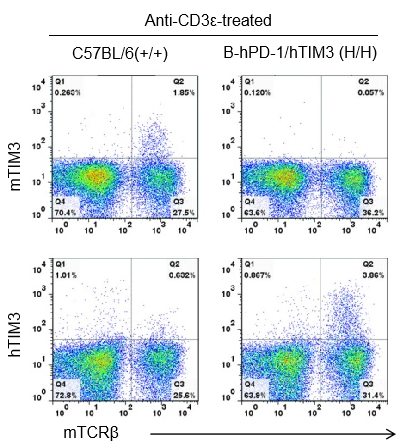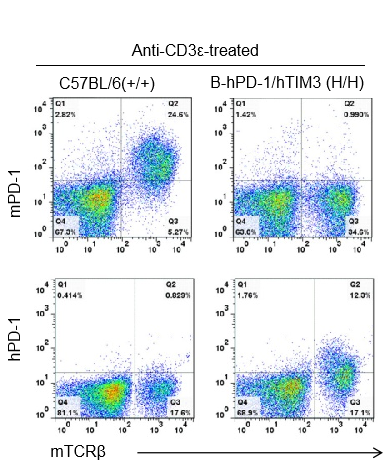| Strain Name |
C57BL/6-Pdcd1tm1(PDCD1)Bcgen Havcr2tm1(HAVCR2)Bcgen/Bcgen
|
Common Name | B-hPD-1/hTIM3 mice |
| Background | C57BL/6 | Catalog number | 120524 |
|
Related Genes |
PD-1(Programmed death-1) ; HAVCR2 (hepatitis A virus cellular receptor 2) |
||
|
NCBI Gene ID |
18566,171285 | ||
mRNA expression analysis

Strain specific analysis of PD-1/TIM3 gene expression in WT and hPD-1/hTIM3 mice by RT-PCR. Mouse Pd-1/Tim3 mRNA were detectable in splenocytes of wild-type (+/+) mice. Human PD-1/TIM3 mRNA were detectable only in H/H but not in +/+ mice.

Strain specific TIM3 expression analysis in homozygous B-hPD-1/hTIM3 mice by flow cytometry. Splenocytes were collected from WT and homozygous B-hPD-1/hTIM3 (H/H) mice stimulated with anti-CD3ε in vivo, and analyzed by flow cytometry with species-specific anti-TIM3 antibody. Mouse TIM3 was detectable in WT mice. Human TIM3 was exclusively detectable in homozygous B-hPD-1/hTIM3 but not WT mice.

Strain specific PD-1 expression analysis in homozygous B-hPD-1/hTIM3 mice by flow cytometry. Splenocytes were collected from WT and homozygous B-hPD-1/hTIM3 (H/H) mice stimulated with anti-CD3ε in vivo, and analyzed by flow cytometry with species-specific anti-PD-1 antibody. Mouse PD-1 was detectable in WT mice. Human PD-1 was exclusively detectable in homozygous B-hPD-1/hTIM3 but not WT mice.









